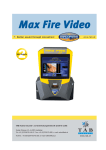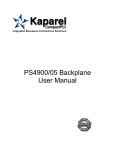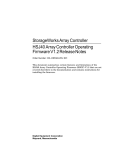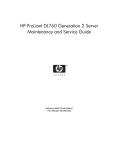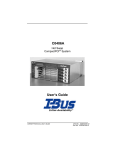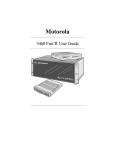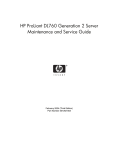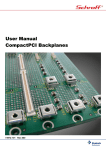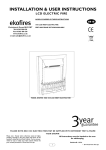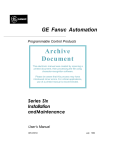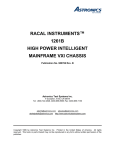Download Model 6276 ForeFront Half-Pipe Chassis Assembly User Guide
Transcript
Model 6276 ForeFront Half-Pipe Chassis Assembly User Guide Sales Office: +1 (301) 975-1000 Technical Support: +1 (301) 975-1007 E-mail: [email protected] URL: www.patton.com Document Number: 120011U Rev. B Part Number: 07M6276 Revised: August 29, 2003 Contact Information Patton Electronics Company, Inc. 7622 Rickenbacker Drive Gaithersburg, MD 20879 USA tel: +1 (301) 975-1000 fax: +1 (301) 869-9293 support: +1 (301) 975-1007 url: www.patton.com e-mail: [email protected] Copyright Statement Copyright © 2003, Patton Electronics Company. All rights reserved. Trademark Statement The terms ForeFront and Half-Pipe are trademarks of Patton Electronics Company. CompactPCI and PICMG are registered trademarks of the PCI Industrial Computer Manufacturers Group. All other trademarks presented in this document are the property of their respective owners. Notices The information contained in this document is not designed or intended for use as critical components in human life-support systems, equipment used in hazardous environments, or nuclear control systems. Patton Electronics Company disclaims any express or implied warranty of fitness for such uses. The information in this document is subject to change without notice. Patton Electronics assumes no liability for errors that may appear in this document. Any software described in this document is furnished under license and may be used or copied only in accordance with the terms of such license. Contents Contents ......................................................................................................................................................... 3 Compliance Information ................................................................................................................................ 7 Radio and TV Interference ...............................................................................................................................7 Industry Canada Notice ....................................................................................................................................7 FCC Part 68 Compliance Statement .................................................................................................................7 CE Notice .........................................................................................................................................................8 About this guide.....................................................................................................................................................9 Audience................................................................................................................................................................. 9 Structure................................................................................................................................................................. 9 Precautions ........................................................................................................................................................... 10 Style conventions used in this document............................................................................................................... 10 Typographical conventions used in this document................................................................................................ 11 General conventions .......................................................................................................................................11 Mouse conventions .........................................................................................................................................11 Bibliography ......................................................................................................................................................... 12 1 Introduction .................................................................................................................................................. 13 Product features and benefits .................................................................................................................................14 What is CompactPCI?...........................................................................................................................................14 2 Chassis specifications .................................................................................................................................... 15 2U CPCI subrack ..................................................................................................................................................16 Description of chassis front side.............................................................................................................................17 Description of chassis rear side...............................................................................................................................18 Electromagnetic compatibility (EMC)...................................................................................................................19 Electrostatic discharge (ESD) protection................................................................................................................20 Fan tray assembly ..................................................................................................................................................22 Chassis system specifications..................................................................................................................................23 Power considerations .............................................................................................................................................23 3 System architecture ....................................................................................................................................... 25 CompactPCI form factor.......................................................................................................................................26 Board front panels ...........................................................................................................................................27 Transition boards ............................................................................................................................................27 Pin and socket connectors......................................................................................................................................29 J1/P1 & J2/P2 connectors ...............................................................................................................................30 J3/P3 through J5/P5 connector .......................................................................................................................30 Reserved pins ..................................................................................................................................................30 Power pins ......................................................................................................................................................30 Backplane architecture...........................................................................................................................................30 Slot designation ..............................................................................................................................................32 Backplane power distribution ................................................................................................................................32 3 Contents Model 6276 2U CPCI Chassis Assembly External power connections ............................................................................................................................33 Front panel keying for power supplies .............................................................................................................33 Hot-swap capability...............................................................................................................................................33 4 Installation checklist ..................................................................................................................................... 35 2U quick set-up checklist.......................................................................................................................................36 Power cable installation ...................................................................................................................................36 Installing the power cables—AC unit ........................................................................................................36 Installing the power cables—DC unit .......................................................................................................37 Grounding the Model 6276—AC and DC units ......................................................................................38 Changing the VI/O configuration jumper .......................................................................................................38 Optional frame ground/signal ground connect ................................................................................................38 5 Maintenance.................................................................................................................................................. 39 Preventive maintenance .........................................................................................................................................40 Clean fan filter ................................................................................................................................................40 Troubleshooting ....................................................................................................................................................40 System won’t power up ...................................................................................................................................40 No-load condition generates a false alarm .......................................................................................................40 6 Contacting Patton for assistance ................................................................................................................... 41 Introduction ..........................................................................................................................................................42 Contact information..............................................................................................................................................42 Service ............................................................................................................................................................42 Warranty Service and Returned Merchandise Authorizations (RMAs)...................................................................42 Warranty coverage ..........................................................................................................................................43 Out-of-warranty service .............................................................................................................................43 Returns for credit ......................................................................................................................................43 Return for credit policy .............................................................................................................................43 RMA numbers ................................................................................................................................................43 Shipping instructions ................................................................................................................................43 A Glossary of terms .......................................................................................................................................... 45 C ...........................................................................................................................................................................46 CFM ...............................................................................................................................................................46 CSA ................................................................................................................................................................46 CT ..................................................................................................................................................................46 D...........................................................................................................................................................................46 Dual Redundant .............................................................................................................................................46 E............................................................................................................................................................................46 ECTF .............................................................................................................................................................46 EIA .................................................................................................................................................................46 EMC ...............................................................................................................................................................46 EMI ................................................................................................................................................................46 EN ..................................................................................................................................................................46 Enumeration ...................................................................................................................................................46 4 Model 6276 2U CPCI Chassis Assembly Contents ESD ................................................................................................................................................................46 Eurocard .........................................................................................................................................................46 H...........................................................................................................................................................................46 Hot-Swap .......................................................................................................................................................46 HP ..................................................................................................................................................................46 I.............................................................................................................................................................................47 IDE ................................................................................................................................................................47 IEC .................................................................................................................................................................47 IEEE ...............................................................................................................................................................47 IN/C ...............................................................................................................................................................47 ISA ..................................................................................................................................................................47 K ...........................................................................................................................................................................47 Keying ............................................................................................................................................................47 N...........................................................................................................................................................................47 N+1 Redundant ..............................................................................................................................................47 NEBS .............................................................................................................................................................47 NP ..................................................................................................................................................................47 P............................................................................................................................................................................47 PCI .................................................................................................................................................................47 PCI SIG ..........................................................................................................................................................47 PICMG ..........................................................................................................................................................47 Platform ..........................................................................................................................................................47 S ............................................................................................................................................................................47 SELV ..............................................................................................................................................................47 S-HAZ ............................................................................................................................................................47 Shroud ............................................................................................................................................................48 T ...........................................................................................................................................................................48 TDM ..............................................................................................................................................................48 TNV ...............................................................................................................................................................48 U ...........................................................................................................................................................................48 U ....................................................................................................................................................................48 W ..........................................................................................................................................................................48 Warm-Swap ....................................................................................................................................................48 5 Contents 6 Model 6276 2U CPCI Chassis Assembly Compliance Information Radio and TV Interference The Model 6276 ForeFront™ Half-Pipe™ Chassis generates and uses radio frequency energy, and if not installed and used properly—that is, in strict accordance with the manufacturer’s instructions—may cause interference to radio and television reception. The Model 6276 ForeFront Half-Pipe has been tested and found to comply with the limits for a Class A computing device in accordance with the specifications in Subpart B of Part 15 of FCC rules, which are designed to provide reasonable protection from such interference in a commercial installation. However, there is no guarantee that interference will not occur in a particular installation. If the Model 6276 ForeFront Half-Pipe Chassis causes interference to radio or television reception, which can be determined by disconnecting the cables, try to correct the interference by one or more of the following measures: moving the computing equipment away from the receiver, re-orienting the receiving antenna, and/or plugging the receiving equipment into a different AC outlet (such that the computing equipment and receiver are on different branches). In order to comply with UL60950 leakage current requirements, it is recommended that the AC inputs be supplied from separate and isolated sources. Industry Canada Notice The Canadian Department of Communications label identifies certified equipment. This certification means that the equipment meets certain telecommunications network protective, operational and safety requirements. The Department does not guarantee the equipment will operate to the user's satisfaction. Before installing this equipment, users should ensure that it is permissible to be connected to the facilities of the local telecommunications company. The equipment must also be installed using an acceptable method of connection. In some cases, the company’s inside wiring associated with a single line individual service may be extended by means of a certified connector assembly (telephone extension cord). The customer should be aware that compliance with the above condition may not prevent degradation of service in some situations. Repairs to some certified equipment should be made by an authorized maintenance facility designated by the supplier. Any repairs or alterations made by the user to this equipment, or equipment malfunctions, may give the telecommunications company cause to request the user to disconnect the equipment. Users should ensure for their own protection that the ground connections of the power utility, telephone lines and internal metallic water pipe system, are connected together. This protection may be particularly important in rural areas. Users should not attempt to establish or modify ground connections themselves, instead they should contact the appropriate electric inspection authority or electrician. FCC Part 68 Compliance Statement This equipment complies with Part 68 of the FCC rules and the requirements adopted by the ACTA. Refer to the plugin cards’ user guide for details. 7 Model 6276 2U CPCI Chassis Assembly CE Notice The CE symbol on your Patton Electronics equipment indicates that it is in compliance with the Electromagnetic Compatibility (EMC) directive and the Low Voltage Directive (LVD) of the European Union (EU). A Certificate of Compliance is available by contacting Technical Support. 8 About this guide This manual is a comprehensive hardware reference tool for the Patton Electronics 2U CPCI Redundant Backplane/Midplane and Chassis line of products. Audience This guide is intended for the following users: • • • • System developers installing and integrating the products into their systems Operators Installers Maintenance technicians Structure This guide contains the following chapters and appendices: • Chapter 1, “Introduction” on page 13—provides an overview of the product, about Patton Electronics, warranty, and service information. • Chapter 2, “Chassis specifications” on page 15—provides an overview of the chassis features. • Chapter 3, “System architecture” on page 25—provides a quick set-up checklist for installing the Model 6276. • Chapter 4, “Installation checklist” on page 35—provides an overview of CompactPCI specifications, as well as a more in-depth description of the product’s features. • Chapter 5, “Maintenance” on page 39—provides a quick set-up checklist, tips for troubleshooting, warranty information, and where to get help. • Appendix A, “Glossary of terms” on page 45—defines terms and acronyms used in this document. For best results, read the contents of this guide before you install the enclosure. 9 About this guide Model 6276 2U CPCI Chassis Assembly Precautions Notes and cautions, which have the following meanings, are used throughout this guide to help you become aware of potential problems. Warnings relate to personal injury issues, and Cautions refer to potential property damage. Note Calls attention to additional or noteworthy information or tips. The shock hazard symbol and WARNING heading indicate a potential electric shock hazard. Strictly follow the warning instructions to avoid injury caused by electric shock. The alert symbol and WARNING heading indicate a potential safety hazard. Strictly follow the warning instructions to avoid personal injury. The shock hazard symbol and CAUTION heading indicate a potential electric shock hazard. Strictly follow the instructions to avoid property damage caused by electric shock. The alert symbol and CAUTION heading indicate a potential hazard. Strictly follow the instructions to avoid property damage. This symbol and the CAUTION heading indicates a situation where damage to equipment can be caused by electrostatic discharge. . This symbol and the IMPORTANT heading provides information which should be followed for best results when installing, configuring, or operating the Patton product. Style conventions used in this document Tables contain information of a descriptive nature. For example, pin assignments or signal description. Cross-references, figure titles, and table titles are hyperlinked. This means that if you have the on-line version of this document, you can click on the cross-reference and it will “jump” you to that reference within the document. This feature only works with references to sections/tables/figures within this document. References to other documents (for example, PICMG 2.5 R1.0 CompactPCI Computer Telephony Specification) are not hyperlinked. The symbols “/” and “#” indicate signals that are active low. Specific safety-related terms, traceable to certain safety regulatory agency requirements (i.e., IEC950 and harmonized derivative specifications) are used within this manual. Refer to the referenced document for a definition of these terms. 10 Precautions Model 6276 2U CPCI Chassis Assembly About this guide Typographical conventions used in this document This section describes the typographical conventions and terms used in this guide. General conventions The procedures described in this manual use the following text conventions: Table 1. General conventions Convention Meaning Futura bold type Indicates the names of menu bar options. Italicized Futura type Indicates the names of options on pull-down menus. Futura type Indicates the names of fields or windows. Garamond bold type Indicates the names of command buttons that execute an action. <> Angle brackets indicate function and keyboard keys, such as <SHIFT>, <CTRL>, <C>, and so on. Are you ready? All system messages and prompts appear in the Courier font as the system would display them. % dir *.* Bold Courier font indicates where the operator must type a response or command Mouse conventions The following conventions are used when describing mouse actions: Table 2. Mouse conventions Convention Meaning Left mouse button This button refers to the primary or leftmost mouse button (unless you have changed the default configuration). Right mouse button This button refers the secondary or rightmost mouse button (unless you have changed the default configuration). Point This word means to move the mouse in such a way that the tip of the pointing arrow on the screen ends up resting at the desired location. Click Means to quickly press and release the left or right mouse button (as instructed in the procedure). Make sure you do not move the mouse pointer while clicking a mouse button. Double-click Means to press and release the same mouse button two times quickly Drag This word means to point the arrow and then hold down the left or right mouse button (as instructed in the procedure) as you move the mouse to a new location. When you have moved the mouse pointer to the desired location, you can release the mouse button. Typographical conventions used in this document 11 About this guide Model 6276 2U CPCI Chassis Assembly Bibliography The following publications are used in conjunction with this manual. • • • • • • • 12 ECTF H.110 (CT Bus) Specification (Revision 1.0) CompactPCI Hot Swap Specification—PICMG 2.12 (Revision 1.0) CompactPCI Specification—PICMG 2.0 (Revision 3.0) Keying of CompactPCI Boards and Backplanes Specification—PICMG 2.10 (Revision 1.0) UL60950, Safety of Information Technology Equipment, including Electrical Business Equipment IEC 61076-4-101 (1995-05), Specification for 2mm Connector System IEEE 1101.10, IEEE Standard for Additional Mechanical Specifications for Microcomputers using IEEE 1101.1 Equipment Practice Bibliography Chapter 1 Introduction Chapter contents Product features and benefits .................................................................................................................................14 What is CompactPCI?...........................................................................................................................................14 13 1 • Introduction Model 6276 6U cPCI Chassis Assembly Product features and benefits Thank you for purchasing Patton Electronics Co. Model 6276 ForeFront Half-Pipe Chassis with CPCI 2U backplane/midplane. The Model 6276 FireFront Half-Pipe Chassis is a modular 2U x 19 inch rackmount subrack-type CPCI packaging system. The product offers a low cost, turnkey solution for customers desiring four 6U x 160mm slots in the least possible vertical rack space. The superior design also provides up to two power supply modules configured for external DC or AC power input. The rear of the chassis provides four 2U x 80mm slots for CPCI transition modules. Cooling is provided by the specially designed plug-in fan tray module. The Model 6276 ForeFront Half-Pipe Chassis complies with the PICMG 2.0 R3.0 CompactPCI Specification, and PICMG 2.5, ECTF H.110 (CT Bus) Specification (Rev. 1.0), making it an excellent choice for redundant, fault tolerant applications. What is CompactPCI? CompactPCI (Compact Peripheral Component Interconnect) is a high-performance industrial computer platform based on the standard PCI electrical specification in rugged 3U or 2U Eurocard-style packaging, with a high-quality 2mm metric pin and socket connector. CompactPCI is an open specification supported by the PICMG (PCI Industrial Computer Manufacturers Group), which is a consortium of companies involved in utilizing PCI for embedded applications. Distinct advantages of CompactPCI (“CPCI”) include: • Cost/time savings—Because it is electrically compatible with PCI, CPCI allows designers to tap into the wealth of available hardware and software. CPCI provides a substantial reduction in engineering and manufacturing costs because off-the-shelf items can be shipped to meet your configuration needs and delivery schedules. • Rugged and reliable—The Eurocard-style packaging—which includes two-piece shielded connectors for better reliability and vertical card orientation for better cooling—provides a robust system based on a subrack backplane architecture. • Flexibility—CPCI allows either 32- or 64-bit PCI, plus offers an open architecture. Additional connectors are defined for adding standard or proprietary buses or other needs. Hybrid CPCI systems allow bridging to other buses or custom applications. • Hot-swap capability—Boards can be hot-swapped without disrupting operation, a critical feature in realtime and high-availability applications. CompactPCI is rapidly becoming the backbone of today’s high-performance, embedded systems. It is ideally suited for telecommunications, computer telephony, real-time machine control, industrial automation, realtime data acquisition, instrumentation, military systems and other applications requiring high speed computing and modular, robust packaging design. 14 Product features and benefits Chapter 2 Chassis specifications Chapter contents 2U CPCI subrack ..................................................................................................................................................16 Description of chassis front side.............................................................................................................................17 Description of chassis rear side...............................................................................................................................18 Electromagnetic compatibility (EMC)...................................................................................................................19 Electrostatic discharge (ESD) protection................................................................................................................20 Fan tray assembly ..................................................................................................................................................22 Chassis system specifications..................................................................................................................................23 Power considerations .............................................................................................................................................23 15 2 • Chassis specifications Model 6276 2U CPCI Chassis Assembly 2U CPCI subrack The Model 6276 ForeFront Half-Pipe is a modular 2U x 19 inch rackmount subrack-type packaging system designed for the ForeFront CompactPCI open bus architecture. The rugged, rack-mounted chassis system is ideal for carrier-class, defense, industrial, enterprise, and commercial environments. The 6276 excels in its ease of access, superior cooling, and power distribution. The base unit is adaptable to a wide array of product configurations. Product features include: ✔ Available in AC or DC power supply configurations ✔ Fully compatible with Patton ForeFront modules ✔ EMI shielding on entire assembly, with continuous chassis ground ✔ Lightweight and durable cold-rolled steel construction, suitable for rugged environments ✔ Only 11.70 in. (29.80 cm) deep ✔ Standard powder coating finish ✔ Front mounting flanges for 19 in. rack mount environments Figure 1. Model 6276 16 2U CPCI subrack Model 6276 2U CPCI Chassis Assembly 2 • Chassis specifications Description of chassis front side There are four 6U x 160mm slots (a full CPCI bus segment) at the front of the chassis (see figure 2). Frontentry ForeFront modules, in accordance with PICMG 2.0 R2.1 CompactPCI specifications, are plugged into these slots. Figure 2. Model 6276 ForeFront Half-Pipe Chassis Description of chassis front side 17 2 • Chassis specifications Model 6276 2U CPCI Chassis Assembly The front of the chassis also provides two slots suitable for 3Ux8HP ForeFront power supplies, model 6160 (DC) or 6165 (AC). These devices are described more completely in the 6160/6165 Users Manual. All 6U slots provide 4HP module spacing and are on 0.80 in. centers (except for the power supply slots, which are offset 0.1 inch as per PICMG 2.11 standard). Card guides are molded plastic with metallic ESD contacts (see Electrostatic Discharge (ESD) Protection on page 20) per CompactPCI PICMG 2.0 R3.0 & IEEE 1101.10. Figure 3. Front view of chassis Description of chassis rear side The rear of the chassis is divided into two areas: • A set of four 6U slots for ForeFront transition modules (see figure 2 on page 17). These modules typically contain cable connections for I/O interfaces such as T1/E1 trunks, optical fiber trunks, DSL lines, Ethernet, etc. • A set of 3U slots allocated for the following uses (see figure 4 on page 19): - Power input module—either Patton Model 6112 (DC) or Patton Model 6117 (AC) (see figure 5 on page 19). These modules provide power input to the power supplies in the front of the chassis (see figure 2 on page 17). The input module provides input for both power supplies. - Model 6103 Alarm Card (optional)—provides contact closure alarm relay outputs for external alarm monitoring, 18 Description of chassis rear side Model 6276 2U CPCI Chassis Assembly 2 • Chassis specifications Figure 4. Rear view of chassis Figure 5. AC and DC rear power entry modules Electromagnetic compatibility (EMC) The Model 6276 ForeFront Half-Pipe is designed to provide the highest levels EMC performance—in terms of both interference and susceptibility. The chassis has the following design features to mitigate the effects of electromagnetic interference (EMI): • All gaskets, contacts, and contact surfaces are electrically conductive. • The mating surfaces of the EMC chassis and the EMC plug-in unit front panels and/or optional EMC filler panels are also conductive by use of gaskets/strips. • All chassis and plug-in contact surfaces are connected to a common chassis ground. Electromagnetic compatibility (EMC) 19 2 • Chassis specifications Model 6276 2U CPCI Chassis Assembly Mating EMC gaskets and strips are used on the chassis, front panels of boards, and optional filler panels. An EMC gasket is attached to the bottom of the chassis (front view), and an EMC strip is attached to the top. Plug-in boards have the corresponding mates on the opposite side (see figure 6). Figure 6. EMC strip and gasket on chassis and cards The EMC strip on the left side of the board mates with the EMC gasket attached to the chassis when it is plugged into the first slot. Each board mates together with corresponding gaskets/strips. In addition, all metal components of the subrack are surface treated and conductive. Top, bottom, sides and rear EMC covers provide mechanical protection and EMC shielding on the subrack. Retaining clips ensure conductive connection. The chassis contains an optional frame ground to signal ground jumper. By default, in all ForeFront Half-Pipe products, this jumper is not installed. This means that frame ground (the electrical potential of the chassis shell itself and all panels, screws, etc. that are connected to it) is electrically isolated from the signal ground (the electrical potential corresponding to “0 volts” with respect to the power supplies and cards in the chassis). Patton Electronics recommends that this isolation be maintained, in order to improve the EMC characteristics of the system and the integrity of the two distinct grounds. See the chapter on installation and maintenance for further information on the jumper settings. Electrostatic discharge (ESD) protection The 6276 ForeFront Half-Pipe chassis provides ESD protection in compliance with IEEE 1101.10. ESD contacts are embedded inside and in the front section of card guides for making early as possible contact with a discharge strip on one or both, the upper and/or lower edge of the plug-in board/module. Only one card guide per slot (both front and rear) contain ESD clips. The ESD clip in the card guide is connected to the chassis GND (ground). 20 Electrostatic discharge (ESD) protection Model 6276 2U CPCI Chassis Assembly 2 • Chassis specifications There is an alignment/ESD pin on the injector/ejector handle of boards (see figure 7). Card handle Alignment/ESD pin Figure 7. Alignment/ESD pin on card handle The alignment pin does the following: • Ensures that the connectors are correctly aligned before they engage • Provides solid/protected keying • Provides board ESD contact • Ensures that the EMC gasket is properly aligned (see “Electromagnetic compatibility (EMC)” on page 19) • Ensures that when the board is inserted in the card guide, an integrated ESD clip discharges ESD from the board to the right vertical rail chassis ground. Electrostatic discharge (ESD) protection 21 2 • Chassis specifications Model 6276 2U CPCI Chassis Assembly Figure 8. Model 6270-series fan tray assembly Fan tray assembly Cooling is provided by the specially-designed, Patton Electronics Company, 6270 SeriesPlug-In Fan Tray Module (see figure 8). The unit utilizes three 12 VDC axial cooling fans which are positioned for optimum side-to-side air flow through the subrack. The fan tray is hot-swappable for air filter replacement. Table 3. Fan tray specifications Item Physical Power requirements Performance Reliability Operating environment Fan tray model no. Replacement air filter part no. 22 Description Height: 6.875 in. (17.463 cm) Width: 1.70 in. (4.32 cm) Depth: 10.875 in. (27.623 cm) 1.3 A at 12 VDC 42.5 CFM per fan (quantity: 3 fans) 15,000 hours at 122°F (50°C) 32–122°F (0–50°C), 5–95% relative humidity, non-condensing 51-00180 05-00440-01 Fan tray assembly Model 6276 2U CPCI Chassis Assembly 2 • Chassis specifications Chassis system specifications A list of the 2U model 6276 chassis materials specifications is provided in table 4. Table 4. 2U chassis materials specifications Item Description Physical • Height—2U (5.25 in.) • Width—19 in. (standard EIA rack mount) • Depth—11.70 in. (29.70 cm) DC power interface Rear DC interface panel includes dual ground lugs, -48V DC power interface for N+1 redundant power operation. Rear AC interface panel includes an IEC 320 AC inlet connector equipped with a cord retaining clip, ground lug, and power fuses. Optional power AC Slot configuration • Front—6U x 160 mm slots, Qty: 4 and 3U x 160 mm slots, Qty 2 • Rear—6U X 80 mm slots, Qty: 4 Module keying and alignment Card guides Plug-in unit injector/ejector handles Operating environment Slots are on 0.80 in. (2.0 cm) centers 4HP module spacing, cardguide provides for keying and alignment pin in accordance with IEEE 1101.10, section 6 Molded plastic with snap-in ESD contacts for plug-in module and injector/ejector handle alignment pin Subrack dimensional format accepts modules with injector/ejector handles as specified in IEEE 1101.10, section 8 32–122°F (0–50°C), 5–95% relative humidity, non-condensing Table 5. Power input and power supplies Item Power input Maximum current Power supply fusing Description DC: -48 VDC nominal (-36 to -75V) AC: 115/230 VAC, 50–60 HZ DC: 7.0 A per power input AC: 5.0 A per power input DC: 250 V, 12.5 A, Slow blow (one fuse per PSU) AC: 250 V, 5 A, Slow blow (one fuse per PSU) Power considerations For DC systems, an approved external source must be rated a maximum of 75 VDC, 7.0 A and provide over current protection upstream of the equipment. For DC systems, an approved disconnect device with a minimum 3.0 mm contact separation must be provided upstream of the device and rated at least 75 VDC, 7.0 A and be located so it is accessible to the operator. For DC systems, this equipment shall be connected directly to the DC supply system bonding jumper from an earthing terminal bar or bus to which the DC supply system earthing electrode is connected. For DC systems, this equipment shall be located in the same immediate area as any other equipment that has a connection between the earthed conductor of the same DC supply circuit and the earthing conductor, and also the point of earthing of the DC system. The DC system shall not be earthed elsewhere. Chassis system specifications 23 2 • Chassis specifications Model 6276 2U CPCI Chassis Assembly For DC systems, there shall be no switching or disconnecting devices in the earthed circuit conductor between the DC source and the point of connection of the earthing electrode conductor. When used with AC supplies, the device must be connected to an earthed mains socket outlet. 24 Power considerations Chapter 3 System architecture Chapter contents CompactPCI form factor.......................................................................................................................................26 Board front panels ...........................................................................................................................................27 Transition boards ............................................................................................................................................27 Pin and socket connectors......................................................................................................................................29 J1/P1 & J2/P2 connectors ...............................................................................................................................30 J3/P3 through J5/P5 connector .......................................................................................................................30 Reserved pins ..................................................................................................................................................30 Power pins ......................................................................................................................................................30 Backplane architecture...........................................................................................................................................30 Slot designation ..............................................................................................................................................32 Backplane power distribution ................................................................................................................................32 External power connections ............................................................................................................................33 Front panel keying for power supplies .............................................................................................................33 Hot-swap capability...............................................................................................................................................33 25 3 • System architecture Model 6276 2U CPCI Chassis Assembly CompactPCI form factor CompactPCI is flexible in the mechanical and connector area, using a passive backplane and plug-in daughterboards. The architecture is based on the IEC 1101.10 and 1101.11 Eurocard standard for the fixed 160mm depth (for front boards), but allows for two board heights: • 3U—100 mm high • 2U—233.35 mm high This variety enables a wider variety of applications and industries. 3U, which is the minimum for CompactPCI as it accommodates the full 64-bit CompactPCI bus, is popular for embedded industrial automation applications, while 2U provides additional board real estate for more complex applications. 2U also provides more connectors for rear-panel I/O often needed in telecom products. Eurocard boards offer a long list of advantages: ✔ Extensive board keying capabilities so that boards can only be plugged into appropriate slots ✔ Card guides for solid rear backplane connectors alignment ✔ Injector/ejector handles ✔ EMC compliance that minimizes electromagnetic interference CompactPCI boards are inserted at the front of the chassis—which provides maximum configuration flexibility—with options for I/O connections to either the front and/or rear of the card. The cards are firmly held in position by their connector, card guides on both sides, and a face plate which solidly screws into the card cage. 26 CompactPCI form factor Model 6276 2U CPCI Chassis Assembly 3 • System architecture Board front panels CompactPCI boards provide a front panel interface that is consistent with Eurocard packaging and compliant with IEEE 1101.10 (EMC panels). Ejector/injector handles are used on the boards (see figure 9). Filler panels do not require handles. Figure 9. Front panel—6U front-entry card Transition boards There are two types of boards: • Front-entry boards (described in section “Board front panels”) • Rear-entry boards for rear-panel I/O The front-entry boards may route I/O through the backplane. Backplanes that enable rear I/O are called often midplanes because the legs of the backplane connector’s pins stick through the board to become pins for rear- CompactPCI form factor 27 3 • System architecture Model 6276 2U CPCI Chassis Assembly panel interconnections. An illustration of the front-entry board and rear-panel I/O board interface with the backplane/midplane is shown in figure 10. Figure 10. Front/rear boards and backplane interface Rear-panel I/O boards are either 3U or 6U in width and are typically 80mm in depth. Other depths are allowed depending on the application requirements. The 2U chassis provides an 80mm transition module section. This section provides four 6U x 80mm slots for cPCI transition modules. All front-entry board features (handles, keying, alignment pin, EMC, etc.) are also utilized on the rear-entry boards. The rear-panel I/O transition boards are “in-line” with the front-entry boards. This means that the front panels of rear-panel I/O transition boards are reversed (mirrored) from the front boards. The top handles are on the bottom and vice versa. The slot keying holes and hole labels in both the card guides and front panels are upside down compared to the front boards and card guides. The same connector pin labeling sequence is used on the rear I/O transition boards as on the front boards, with the position numbers going from bottom to top. This is a mirror image of the front board’s layout orientation. Using the same 1-for-1 pin mapping sequence eliminates confusion and I/O signal pin mapping problems. For example, pin A3 is the same on the front boards, on the rear I/O transition board, and on the backplane. 28 CompactPCI form factor Model 6276 2U CPCI Chassis Assembly 3 • System architecture Rear-panel I/O transition boards may have active components in some applications. Power can be applied either through the I/O pins from the front board, or from the normal power and ground pins defined as part of the J1/P1 and J2/P2 connector pin assignments. Pin and socket connectors The connection between boards and backplane is through a two-piece, 2 mm connector. Backplanes use male (pin) connectors and plug-in boards use female (socket) connectors. This pin and socket connector offers greater reliability, particularly when subject to shock, vibration, or temperature variations. These pin and socket connectors provide: • Faster propagation times • Reduced reflection at the bus/connector interface • Lower noise • Better impedance matching • Higher mechanical stability The connector is a 235-pin device, arranged in 47 rows of 5 pins, with a total of 220 pins (15 pins are lost to the keying area). The connector is shielded and devotes a large number of pins to ground. This reduces reflections, increases EMI immunity in noisy environments, and reduces ground bounce. The fixed or male connector on the backplane is numbered P1-P5, starting at the bottom. The corresponding female connectors are also numbered from the bottom up as follows: • 6U cards—J1-J5 (see figure 11) Figure 11. J1 through J5 connectors on the 6U card Pin and socket connectors 29 3 • System architecture Model 6276 2U CPCI Chassis Assembly 3U and 6U cards use a single 220 pin connector for all power, ground, and all 32- and 64-bit PCI signals. This connector consists of two halves—the lower half (110 pins) is called J1/P1 and the upper half (also 110 pins) is called J2/P2. Twenty pins are reserved for future use. The connector is divided in J1/P1, a 25-row connector that includes voltage keying, and J2/P2, a 22-row connector without keying. The 2U card can have up to four additional connectors with a total of 315 pins, which can be used for a variety of purposes. A system CPU uses J1 and J2, but 32-bit peripherals cards only need to use J1 for full CompactPCI functionality. J3 through J5 on 2U cards can be user-defined I/O. Optional buses, such as the CT H.110 bus, use the J4 position. J1/P1 & J2/P2 connectors The CompactPCI bus spans the J1/P1 & J2/P2 connectors, with 32-bit PCI implemented on J1/P1 and full 64-bit PCI implemented on J2/P2 on the Model 6276 Midplane. J1/P1 is always devoted to 32-bit PCI in CompactPCI systems, however, use of J2/P2 for 64-bit PCI can be optional. For instance, J2/P2 may be defined for user I/O, or sub-buses like the CT H.110 bus. J2 is always used on system slot boards to provide arbitration and clock signals for peripheral boards. J3/P3 through J5/P5 connector J3/P3 through J5/P5 connectors, available only in 2U systems, are generally defined for user I/O. However, sub-bus interconnects (for example, CT H.110 bus) can be configured on the J4/P4 connector. Reserved pins There are bused and non-bused reserved pins as noted below: • The BRSVPxxx signals SHALL be bused between connectors and are reserved for future CompactPCI definition. • The RSV signals are non-bused signals that shall be reserved for future CompactPCI definition. Power pins The 2U Model 6276 Backplane/Midplane has a selectable signaling environment. All connectors on the 2U Model 6276 Backplane/Midplane provide pins for +5V, +3.3V, +12V and -12V operating power. In addition, there are power pins labeled +V(I/O). The V(I/O) power pins on the connector are used to power the buffers on the peripheral boards, allowing a card to be designed to work in either interface. In a ForeFront environment, the V(I/O) pins must always be configured for 3.3 VDC. This is selected by a strap on the mid-plane. Backplane architecture Patton Electronics Company, 2U Model 6276 Backplane/Midplane provides one CompactPCI bus segment. The cPCI bus segment is composed of four 6U board locations (at 33 MHz) with 20.32 mm (0.8 inch) board center-to-center spacing. The 6U cards are stacked horizontally in the 2U model, however, the special design provides vertical convection cooling with the installed plug-in fan tray module (See Fan Tray Assembly on page 22). 30 Backplane architecture Model 6276 2U CPCI Chassis Assembly 3 • System architecture There are also two 3U x 160mm slots on the front right side, called the “Power Bay”, to mount Patton Power Supply Modules configured for external DC or AC power input. A rear view of the 2U Model 6276 is shown in figure 12. Figure 12. Rear view of chassis showing the midplane/backplane There are two user-configurable straps and a DIP switch located in the rear 3U area of the chassis. • VIO signaling—This strap (using J1, J2, J3) sets the V I/O signaling voltage to 3.3 or 5 VDC. For all ForeFront applications, this should be set to 3.3v. Do not change it from this setting. • Frame ground/signal ground—This strap (using J4, J5) allows the user to electrically connect frame ground (FG) to signal ground (SG). By default, these signals are electrically isolated. Patton Electronics recBackplane architecture 31 3 • System architecture Model 6276 2U CPCI Chassis Assembly ommends that this configuration be maintained. However, in certain specific circumstances, users may wish to connect these two potentials by installing a jumper between J4 and J5. • Shelf Geographic Address (SGA)—S1 has a DIP switch that enables the user to configure the shelf enumeration feature, used for multi-shelf CompactPCI systems. The SGA effectively becomes a chassis identification code, which is used to uniquely identify the chassis in a multi-chassis environment. This is currently not used in most ForeFront applications, as most cards/devices are uniquely identified by an IP address, which is manually configured for each device in the system. Slot designation Consistent with CompactPCI specifications, the cPCI bus segment consists of one system slot, and three peripheral slots. The system slot is located in the first slot, or bottom slot in the 2U model. The system slot provides arbitration, clock distribution, and reset functions for all boards on the segment. The system slot performs system initalization by managing each local board’s IDSEL signal. The peripheral slots may contain simple boards, intelligent slaves, or PCI bus masters. CompactPCI defines slot numbering based on the concept of physical and logical slots. Physical backplane slots are designated 1, 2, 3, through N, where N is the number of slots. Physical slot numbering starts at the bottom slot on the 2U Model 6276 Backplane/Midplane. Logical slot numbers are defined by the IDSEL signal and associated address used to select the slot. Logical numbers are used in the nomenclature to define the physical outline of a connector on a bus segment. Logical and physical slot numbers may not always coincide. Backplane power distribution Power is distributed in a CompactPCI system via the backplane. The backplane provides standard direct current (DC) supply voltages as specified in table 6 below: Table 6. Power specifications Mnemonic 5V 3.3 V +12 V -12 V GND 32 Description +5 VDC +3.3 VDC +12 VDC -12 VDC Ground Nominal Value 5.0 V 3.3 V 12.0 V -12.0 V Tolerance ±5% ±5% ±5% ±5% Backplane power distribution Model 6276 2U CPCI Chassis Assembly 3 • System architecture External power connections The chassis provides a rear DC interface panel with -48 VDC power interfaces for N+1 power operation and dual ground lugs, as shown in figure 5 on page 19. The connectors are described in table 7. Table 7. Description of rear interface panel connectors Item Description -48 VDC power DC rear-entry module accepts 36–75 VDC at 7.0 A max input via Phoenix connector. terminal Polarity should be applied as marked (negative—top position, positive—bottom position). AC power The AC power interface accepts 115/230 VAC (50–60 Hz), 5 amp maximum. interface Ground lugs The dual frame ground lugs must be used to connect the chassis to earth ground on DC interfaces. Failure to do this will cause excessive RF emissions and could possibly create a safety hazard. The double ground lug meets NEBS and will accept Amp part # 606209-1. NEBS requires a double lug on DC chassis to ensure that the ground connection will not rotate and become loose. . The dual frame ground lugs on DC interfaces must be used to connect the chassis to earth ground. Failure to do this will cause excessive RF emissions and could possibly create a safety hazard. Front panel keying for power supplies Power supply keying options have been registered with PICMG. Since power supplies use a different type of connector than other CompactPCI slots, there is no possibility of mating problems with 2mm connectors. The power supply key options are independent of the 2mm application card keys, and may duplicate key codes that are used for different purposes elsewhere in the system. Specific front panel keying is defined to prevent damaging an AC power supply inserted into a backplane wired for DC and vice versa. Hot-swap capability Hot-swapping is the capability of removing and replacing components without turning off the system. Hot-swap capability is becoming increasingly important in systems requiring continuous operation at some level. Because boot times of many popular operating systems are long, the hot-swap capability is crucial for high-end PC servers, and even more so for telecommunication systems, such as base stations, where board-level exchanges must be made without any downtime. CompactPCI supports dynamic configuration to allow hot removal/insertion of boards without interrupting backplane transactions or disturbing DC voltages in the power system. The hot-swap feature is implemented on the CPCI boards, not on the backplane. The backplane remains passive. Therefore, CompactPCI boards either are or are not hot-swappable. Signal lines must be precharged to 1V before being plugged into the backplane to maintain ongoing bus transactions. Also, power must be ramped up or down in a controlled manner to allow the power supply to adjust to Hot-swap capability 33 3 • System architecture Model 6276 2U CPCI Chassis Assembly the change in load. The power supply, ground and signal pins on the connectors are staged to allow sequencing, so as to not disturb the operation of the surrounding boards in the bus. The three levels of sequencing are: • Short pins for BD_SEL# • Medium pins for signals • Long pins for power/ground The system uses two levels of sequencing so that power/ground is made first/broken last. The short pin (BD_SEL#) connection is made only when the board is firmly seated, which signals the control circuitry to power up any high-current devices. Conversely, BD_SEL# breaks first to provide early warning to the control circuitry. 34 Hot-swap capability Chapter 4 Installation checklist Chapter contents 2U quick set-up checklist.......................................................................................................................................36 Power cable installation ...................................................................................................................................36 Installing the power cables—AC unit ........................................................................................................36 Installing the power cables—DC unit .......................................................................................................37 Grounding the Model 6276—AC and DC units ......................................................................................38 Changing the VI/O configuration jumper .......................................................................................................38 Optional frame ground/signal ground connect ................................................................................................38 35 4 • Installation checklist Model 6276 2U CPCI Chassis Assembly 2U quick set-up checklist The Model 6276 Mid-plane & Chassis can be easily configured according to your system requirements. Due to the broad application possibilities, the following checklist is provided as a quick set-up guideline. 1. Connect frame ground/signal ground (FG/SG)—You may opt to connect the FG/SG for EMC considerations and noise reduction, via power lugs, located at the rear, right-side of the backplane. This is an optional configuration that is not recommended for most users; the factory default is “no connect”. 2. Assign shelf address—For multi-shelf systems, each sub-rack bus segment can be assigned a shelf address via the S1 header, located at the rear, left-side of the backplane. 3. Install 2U chassis on rack—the chassis front mounting flanges should be securely fastened to the rack with screws. 4. Install power supply modules—For N+1 power operation, install up to two Patton power supply modules at the front of the chassis. 5. Install cards—Plug the system application card(s) in the 6U slot(s) at the front of the 2U chassis. Plug alarm card in the left-hand slot at the back of the chassis, and plug transition cards in remaining slots, if needed. 6. Wire rear panel for power. Due to possible injuries to people and severe damage to objects caused by electric shock, always wire for power as the last step. Power cable installation This section describes installing the power and ground cables. Installing the power cables—AC unit This section describes installing the power cables into the IEC-320 connectors on the Model 6276 power supply. Do not connect the remaining end of the power cables to the power outlet at this time. Do the following: 1. Install a power cable into an IEC-320 connector (see figure 13). The AC main socket outlet shall be within 3 meters of the equipment and shall be easily accessible. Figure 13. IEC-320 connector and grounding stud locations 36 2U quick set-up checklist Model 6276 2U CPCI Chassis Assembly 4 • Installation checklist To avoid the risk of injury from electric shock, the power cords connected to the IEC-320 connectors must be grounded power cords. 2. Rotate the power cable retainer clip (see figure 13) so it secures the power cable plug in the IEC-320 connector. Installing the power cables—DC unit This section describes installing the power cables into the DC power input module. Do not connect the remaining end of the power cables to the DC power source at this time. The Model 6276 DC power supply module comes with two power input terminal blocks (J1 and J2). The Model 6276 can draw power from sources connected to either of these terminal blocks (inputs are diode-ORed and combined to provide for redundant power input). Although the power supply module is designed to operate normally with one power source, users may want to connect two independent power sources, one to each terminal block, to provide uninterrupted operation in the event of one source failure. Use AWG 18 copper conductors for the DC supply. 1. Connect the earth ground of the DC source to the grounding stud on the Model 6276 chassis as described in section “Grounding the Model 6276—AC and DC units” on page 38. 2. Strip back the insulation on each of the supply wires approximately 1/4 inch. 3. Insert the stripped end of the positive lead into the “+DC input” of the terminal block. Tighten the screw until the power lead is firmly fastened. Repeat the procedure for the negative lead, using the “-DC input” of the terminal block. Make sure that there is no exposed wire. Figure 14. DC connector, -DC and +DC input view 4. Repeat steps 1 through 3 to install the remaining DC power connection. 2U quick set-up checklist 37 4 • Installation checklist Model 6276 2U CPCI Chassis Assembly Grounding the Model 6276—AC and DC units Do the following: 1. Assemble a ground wire using #10 AWG wire with green-colored insulation and two ring terminals. Make the wire long enough to reach one of the following ground sources: – The building ground rod (generally located at the site’s main service entrance) – A sprinkler system pipe – A cold-water pipe – Building structural steel To avoid the risk of personal injury, the distance between ground and the equipment rack must not exceed the distance specified in either local electrical codes or the National Electrical Code. 2. Install the ground wire between the grounding studs (see figure 13 on page 36 for AC power entry, or figure 14 on page 37 for DC power entry) and the grounding source. Changing the VI/O configuration jumper The Model 6276 VI/O is factory configured for 3.3V, do not change this setting when using ForeFront cards. Optional frame ground/signal ground connect There are two headers, J1 and J2, located in the power bay area. J1 corresponds to signal ground (SG) and J2 corresponds to frame ground (FG). These two headers provide an option to connect FG and SG. The factory default is for FG and SG to not be connected. Depending on the environment, you can opt to connect the FG/SG (J4/J5) for EMC considerations and noise reduction. 38 2U quick set-up checklist Chapter 5 Maintenance Chapter contents Preventive maintenance .........................................................................................................................................40 Clean fan filter ................................................................................................................................................40 Troubleshooting ....................................................................................................................................................40 System won’t power up ...................................................................................................................................40 No-load condition generates a false alarm .......................................................................................................40 39 5 • Maintenance Model 6276 2U CPCI Chassis Assembly Preventive maintenance Clean fan filter Periodically clean the filter on the Fan Tray Assembly. The frequency of cleaning depends on the environmental conditions of where your equipment is located. Clean filter with a mild detergent and water, then air-dry, or you can use compressed air. It should be completely dry before reuse. Spare filters (part no. 05-00440-01) are available from Patton Electronics Company. Note When replacing the air filter, note that it is directional—the air-flow direction must be in the direction indicated by the arrows on the filter. Troubleshooting System won’t power up If the green LED on the power supply module does not light up, you should remove it from the chassis (warmswap). Then plug it back in, making sure it is seated properly. If green LED still does not light up, check to make sure the polarity is wired correctly at the back of the chassis. If the green LED lights up on the power supply module, but the system still isn’t powering-up, then the module may be faulty and should be returned to the manufacturer. No-load condition generates a false alarm The power supply module may generate a false alarm under a no-load condition (no cards installed). A minimum of 1/2 amp (system admin card would suffice) needs to be plugged into the sub-rack to prevent this false alarm. 40 Preventive maintenance Chapter 6 Contacting Patton for assistance Chapter contents Introduction ..........................................................................................................................................................42 Contact information..............................................................................................................................................42 Service ............................................................................................................................................................42 Warranty Service and Returned Merchandise Authorizations (RMAs)...................................................................42 Warranty coverage ..........................................................................................................................................43 Out-of-warranty service .............................................................................................................................43 Returns for credit ......................................................................................................................................43 Return for credit policy .............................................................................................................................43 RMA numbers ................................................................................................................................................43 Shipping instructions ................................................................................................................................43 41 6 • Contacting Patton for assistance Model 6276 2U CPCI Chassis Assembly Introduction This chapter contains the following information: • “Contact information”—describes how to contact Patton technical support for assistance. • “Warranty Service and Returned Merchandise Authorizations (RMAs)”—contains information about the RAS warranty and obtaining a return merchandise authorization (RMA). Contact information Patton Electronics offers a wide array of free technical services. If you have questions about any of our other products we recommend you begin your search for answers by using our technical knowledge base. Here, we have gathered together many of the more commonly asked questions and compiled them into a searchable database to help you quickly solve your problems. • Online support—available at www.patton.com. • E-mail support—e-mail sent to [email protected] will be answered within 1 business day • Telephone support—standard telephone support is available from 8AM to 5PM EST (8:00 to 17:00 UTC-5), Monday through Friday, by calling +1 (301) 975-1007 Service Patton Electronics' technical staff is also available to answer any questions that might arise concerning the installation or use of your Model 6276. Technical Service hours: 8AM to 5PM EST (8:00 to 17:00 UTC-5), Monday through Friday. All warranty and non-warranty repairs must be returned freight prepaid and insured to Patton Electronics (for more information about warranty and non-warranty repairs, see section “Warranty Service and Returned Merchandise Authorizations (RMAs)”). All returns must have a Return Materials Authorization number on the outside of the shipping container. This number may be obtained from Patton Electronics Technical Service at: • Tel: (301) 975-1007 • E-mail: [email protected] • URL: www.patton.com Note Packages received without an RMA number will not be accepted. Warranty Service and Returned Merchandise Authorizations (RMAs) Patton Electronics is an ISO-9001 certified manufacturer and our products are carefully tested before shipment. All of our products are backed by a comprehensive warranty program. Note 42 If you purchased your equipment from a Patton Electronics reseller, ask your reseller how you should proceed with warranty service. It is often more convenient for you to work with your local reseller to obtain a replacement. Patton services our products no matter how you acquired them. Introduction Model 6276 2U CPCI Chassis Assembly 6 • Contacting Patton for assistance Warranty coverage Our products are under warranty to be free from defects, and we will, at our option, repair or replace the product should it fail within one year from the first date of shipment. Our warranty is limited to defects in workmanship or materials, and does not cover customer damage, lightning or power surge damage, abuse, or unauthorized modification. Out-of-warranty service Patton services what we sell, no matter how you acquired it, including malfunctioning products that are no longer under warranty. Our products have a flat fee for repairs. Units damaged by lightning or other catastrophes may require replacement. Returns for credit Customer satisfaction is important to us, therefore any product may be returned with authorization within 30 days from the shipment date for a full credit of the purchase price. If you have ordered the wrong equipment or you are dissatisfied in any way, please contact us to request an RMA number to accept your return. Patton is not responsible for equipment returned without a Return Authorization. Return for credit policy • Less than 30 days: No Charge. Your credit will be issued upon receipt and inspection of the equipment. • 30 to 60 days: We will add a 20% restocking charge (crediting your account with 80% of the purchase price). • Over 60 days: Products will be accepted for repairs only. RMA numbers RMA numbers are required for all product returns. You can obtain an RMA by doing one of the following: • Completing a request on the RMA Request page in the Support section at www.patton.com • By calling +1 (301) 975-1000 and speaking to a Technical Support Engineer • By sending an e-mail to [email protected] All returned units must have the RMA number clearly visible on the outside of the shipping container. Please use the original packing material that the device came in or pack the unit securely to avoid damage during shipping. Shipping instructions The RMA number should be clearly visible on the address label. Our shipping address is as follows: Patton Electronics Company RMA#: xxxx 7622 Rickenbacker Dr. Gaithersburg, MD 20879-4773 USA Patton will ship the equipment back to you in the same manner you ship it to us. Patton will pay the return shipping costs. Warranty Service and Returned Merchandise Authorizations (RMAs) 43 6 • Contacting Patton for assistance 44 Model 6276 2U CPCI Chassis Assembly Warranty Service and Returned Merchandise Authorizations (RMAs) Appendix A Glossary of terms Chapter contents C ....................................................................................46 CFM .......................................................................46 CSA ........................................................................46 CT ..........................................................................46 D....................................................................................46 Dual Redundant ......................................................46 E ....................................................................................46 ECTF ......................................................................46 EIA ..........................................................................46 EMC .......................................................................46 EMI ........................................................................46 EN ..........................................................................46 Enumeration ...........................................................46 ESD ........................................................................46 Eurocard .................................................................46 H ...................................................................................46 Hot-Swap ................................................................46 HP ..........................................................................46 I .....................................................................................47 IDE .........................................................................47 IEC .........................................................................47 IEEE .......................................................................47 IN/C .......................................................................47 ISA ..........................................................................47 K ................................................................................... 47 Keying .................................................................... 47 N................................................................................... 47 N+1 Redundant ..................................................... 47 NEBS ..................................................................... 47 NP .......................................................................... 47 P.................................................................................... 47 PCI ......................................................................... 47 PCI SIG ................................................................. 47 PICMG .................................................................. 47 Platform ................................................................. 47 S .................................................................................... 47 SELV ...................................................................... 47 S-HAZ ................................................................... 47 Shroud .................................................................... 48 T ................................................................................... 48 TDM ...................................................................... 48 TNV ...................................................................... 48 U ................................................................................... 48 U ............................................................................ 48 W .................................................................................. 48 Warm-Swap ............................................................ 48 45 Model 6276 2U CPCI Chassis Assembly A • Glossary of terms C CFM Cubic feet per minute—A measurement of how much air is moved through a fan. CSA Canadian Standards Association—Organization which operates a listing service for electrical and electronic materials and equipment. It is the body that establishes telephone equipment (and other) standards for use in Canada. CT Computer Telephony—is the adding of computer intelligence to the making, receiving, and managing of telephone calls. D Dual Redundant An environment containing two power supplies, with fault tolerance such that one power supply may fail and the system will continue to operate. E ECTF Enterprise Computer Telephony Forum—A nonprofit corporation formed to focus on the technical challenges of interoperability among Computer Telephony Integration (CTI) products. EIA Electronics Industry Association—Trade organization of manufacturers which sets standards for use of its member companies. EMC Electromagnetic Compatibility—Is the ability of equipment or systems to be used in their intended environment within designed efficiency levels without causing or receiving degradation due to unintentional EMI. 46 EMI Electromagnetic Interference—any electromagnetic interference, periodic or random, narrow or broadband, which may have a disturbing influence on devices exposed to it. EN European Norms—Prefix assigned to documents adopted by the CE designating required standards (for example, EN 60950 is the safety specification (equivalent to UL 1950)). Enumeration The action taken by the Host to poll the configuration spaces of the PCI devices and allocate (deallocate) the necessary resources (memory and/or I/O address space, interrupts, software drivers). ESD Electrostatic Discharge—Discharge of a static charge on a surface or body through a conductive path to ground. Can be damaging to integrated circuits. Eurocard A series of mechanical board form factor sizes for rack-based systems. H Hot-Swap The capability of removing and replacing components without turning off the system. Hot-swap capability is increasingly important in systems used for applications such as telecommunications, which require that the system be operational at some level continuously. HP Horizontal Positioning—A unit of measurement used for the width of CPCI cards/modules. 1 HP = 0.2 inch wide C Model 6276 2U CPCI Chassis Assembly I IDE Integrated Drive Electronics—a hard disk drive standard interface for PCs. IEC International Electrotechnical Committee IEEE Institute of Electrical and Electronics Engineers IN/C Insulation No Connect—required for safety agency insulation requirements. ISA Industry Standard Architecture—A specification by which Personal Computers (PCs) add boards. K Keying A mechanical means of polarizing connectors in order to prevent similar connectors from being mated. This is necessary when 2 or more similar connectors must be connected to a backplane which requires that the board being connected is unique for a particular slot. N N+1 Redundant An environment containing more than two power supplies, where the power supplies typically current share, with fault tolerance such that one power supply may fail and the system will continue to operate. NEBS Network Equipment Building Standards—Defines a rigid and extensive set of performance, quality, environmental and safety requirements developed by Bellcore, the R&D and standards organization owned by the seven regional Bell operating companies (RBOC’s). I A • Glossary of terms NP Not Populated—pins within connector that must not be populated due to safety requirements. P PCI Peripheral Component Interconnect. A specification for defining between logic components. Typically used for interconnecting high-speed, PC-compatible chipset components. The PCI specification is issued through the PCI Special Interest Group (PCI SIG). PCI SIG Peripheral Component Interconnect Special Interest Group PICMG PCI Industrial Computers Manufacturers Group—a consortium of industrial computer product vendors who develop specifications for PCI-based systems and boards for use in industrial computing applications. Platform Describes the system environment, including the backplane and related enclosure. S SELV Safety Extra Low Voltage—a term generally defined by the regulatory agencies as the highest voltage that can be contacted by a person and not cause injury. It is often specifically defined as 30 VAC or 42.4 VDC. S-HAZ Secondary Hazardous—any voltage within a system that is greater than 60VDC (42.4VAC-peak), NOT meeting the requirements for a LIMITED CURRENT CIRCUIT, or for a TNV CIRCUIT. Typical ringing voltage is considered SECONDARY HAZARDOUS unless it is current limited. Raw ringing is considered SECONDARY HAZARDOUS. (Refer to IEC950 or PICMG 2.5 R1.0 CompactPCI‚ Computer Telephony Specification for information.) 47 A • Glossary of terms Model 6276 2U CPCI Chassis Assembly Shroud A male connector body designed to fit over the extended tails of a long tail connector which allows a female connector to be mated from the rear side for midplane or rear I/O applications. T TDM Time Division Multiplex—A technique for transmitting a number of separate data, voice and/or video signals simultaneously over one communications medium by quickly interleaving a piece of each signal one after another. TNV Telephone Network Voltages—any voltage present on the telephone network side of the isolation device on any device (for example, board) that connects to the telephone network. U U An EIA unit of measurement equal to 1.75 in. (4.45 cm) for equipment racks. W Warm-Swap An environment supporting removal and insertion of power supplies while under power, wherein the power supply is disabled during insertion and removal, avoiding the need for the connectors to make and break high current connections while under load. 48 T
















































